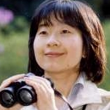40th Birthday of Former Princess Nori of Japan
Sayako Kuroda, the former Princess Nori and only daughter of Emperor Akihito and Empress Michiko of Japan, is celebrating her 40th birthday today. As the princess left the Imperial Family and became a commoner on the day of her wedding to Yoshiki Kuroda in November 2005, no official birthday celebrations will be held. In all likeliness, though, the family is going to have a nice birthday party in private as the princess has always been a great favourite with her parents. On her wedding day, the Emperor and the Empress even broke tradition in order to attend the wedding. (According to custom, the newlyweds will present themselves to the Emperor and Empress after the wedding has taken place, and this tradition had never been broken before. At their sons’ weddings in 1990 and 1993, Emperor and Empress had not been present.)
Sayako, Princess Nori, was born on 18 April 1969 as third child of her parents (who were, at the time of Sayako’s birth, still Crown Prince and Crown Princess). There are several reasons to call the birth of the little princess a “gift from the universe” on occasion of the 10th wedding anniversary of Akihito and Michiko: she was not only born just eight days after the date of that anniversary; she also turned out to be a very placid, serene character that reminds people of her eldest brother, Crown Prince Naruhito, and of her little niece, Princess Aiko, which can be noted when comparing two baby photos of Sayako and Aiko.
Accordingly, Empress Michiko once said that her daughter was always a source of support at tough times.
On the other hand, one has to admit that the conditions under which Princess Nori grew up were as favourable “for a Japanese princess” as could be. Her mother Michiko had been the first commoner ever to marry into the Imperial Family, and had decided, after she had heard the sad tale of her husband’s lonely childhood, to establish a warm home and family for him. So, the children of the couple grew up in as “normal” a way as possible, considering their exceptional position. This could be said especially of the two younger children, Prince Aya (today Prince Akishino) and Princess Nori. (Their eldest brother, as heir to the throne, received a much harder and stricter education that was meant to render him autonomous and impartial but that, unfortunately, also served to make him nearly incapable of expressing his emotions for the greater part of his life.)
Princess Nori had it, in some respects, easier than even her second brother, Prince Aya. Being a girl meant on one hand that her mother prepared her, already early in her childhood, for a future that would, in all probability, be some day a commoner’s future (Japanese princesses lose all their imperial privileges on the day of their marriage.) For example, Michiko had made a point of having a private kitchen where she herself could prepare sometimes their own meals for the family and teach her daughter to cook. Later in her life, Princess Sayako would always make her own take-away lunch before leaving for work.
While there could be differing opinions concerning the question if this loss of royal status upon marriage is an advantage or a disadvantage for Japanese princesses, it was certainly favourable for little Sayako that Japanese culture – that restricts the expression of emotions and tends to be very non-tactile – is not quite as severe upon females, concerning these points, as it is on males. Please watch the following video that shows imperial family members leaving for or returning from a state visit: first you see Akihito and Michiko taking leave from baby Naruhito, later from an older Naruhito who is trying to prevent his little brother (probably) from running after their parents, and still later you see a scene of Michiko and Akihito coming from a state visit back to their children – now there are already three of them. It is very remarkable indeed how mother and daughter openly show their joy in being with each other again, Michiko hugs her daughter tenderly. The male family members, in the meantime, have to keep their emotions to themselves and are left to watch the females’ embrace, supposedly with envy. (Video)
Princess Nori studied at and graduated from the Department of Japanese Language and Literature, Faculty of Letters, Gakushuin University, in 1992. After that, the princess worked as a part-time researcher at the Yamashina Institute for Ornithology, founded by Yamashina Yoshimaro, a younger son of Prince Yamashina Kikumaro (1873-1908), where she specialized in the study of kingfishers. She contributed articles about birds to various academic works. Apart from her research, she has traveled extensively abroad and within Japan, as a representative of the Imperial Family.
On the yearly birthday news conferences of Princess Nori, journalists had regularly asked her for possible marriage plans, and had never heeded the express wish of the princess to stop putting this question in future. And, surprisingly, on 30 December 2004 the event actually happened, one that probably everybody had ceased to expect: the Imperial Household Agency announced the engagement of Princess Nori to Yoshiki Kuroda, a 40-year-old urban designer with the Tokyo Metropolitan Government, a descendant of Japan’s now-abolished aristocracy and a longtime friend of Prince Akishino. At her engagement news conference, the Princess said that her mother and father had reassured her that her family ties were unchanged and that the Empress had hugged her tightly and told her many times: “Everything’s going to be OK.”
Not everybody was thrilled to hear the news. Just by being herself, the princess had become a poster-girl for Japanese women in their 30s who are not married and still live with their parents. “Frankly I felt happy for her but at the same time shocked,” said a 35-year-old career woman. “An important figure among us is going to get married finally. She was our last stronghold.” (Read an article on the engagement here.)
Today, the former princess is, together with her husband, living as a housewife in a comfortable three-bedroom apartment in Tokyo that was bought with the princess’ dowry of over one million dollars. The couple has no children. Sometimes, the public gets short glimpses of her when she is photographed attending private events with her family, such as concerts or exhibitions.
Click here to watch a video of the former Princess growing up.
Filed under JapanTagged Biography, Birthday, Sayako Kuroda.









Leave a Reply